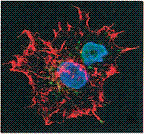Biochemistry, Department of

Gautam Sarath Publications
Document Type
Article
Date of this Version
6-1-2001
Abstract
Nonsymbiotic hemoglobins (ns-Hbs) previously have been found in monocots and dicots; however, very little is known about the tissue and cell type localization as well as the physiological function(s) of these oxygen-binding proteins. We report the immunodetection and immunolocalization of ns-Hbs in rice (Oryza sativa L.) by Western blotting and in situ confocal laser scanning techniques. Ns-Hbs were detected in soluble extracts of different tissues from the developing rice seedling by immunoblotting. Levels of ns-Hbs increased in the germinating seed for the first six days following imbibition and remained relatively constant thereafter. In contrast, ns-Hb levels decreased during leaf maturation. Roots and mesocotyls contained detectable, but low levels of ns-Hbs. Split-seed experiments revealed that ns-Hbs are synthesized de novo during seed germination and are expressed in the absence of any signal originating from the embryo. Immunolocalization of ns-Hbs by con- focal microscopy indicated the presence of ns-Hbs primarily in differentiated and differentiating cell types of the developing seedling, such as the aleurone, scutellum, root cap cells, sclerenchyma, and tracheary elements. To our knowledge, this is the first report of the specific cellular localization of these proteins during seedling development.


Comments
Published in Protoplasma 218 (2001), pp. 125-133. http://www.springerlink.com/content/107724/ Copyright © 2001 Springer-Verlag. Used by permission.